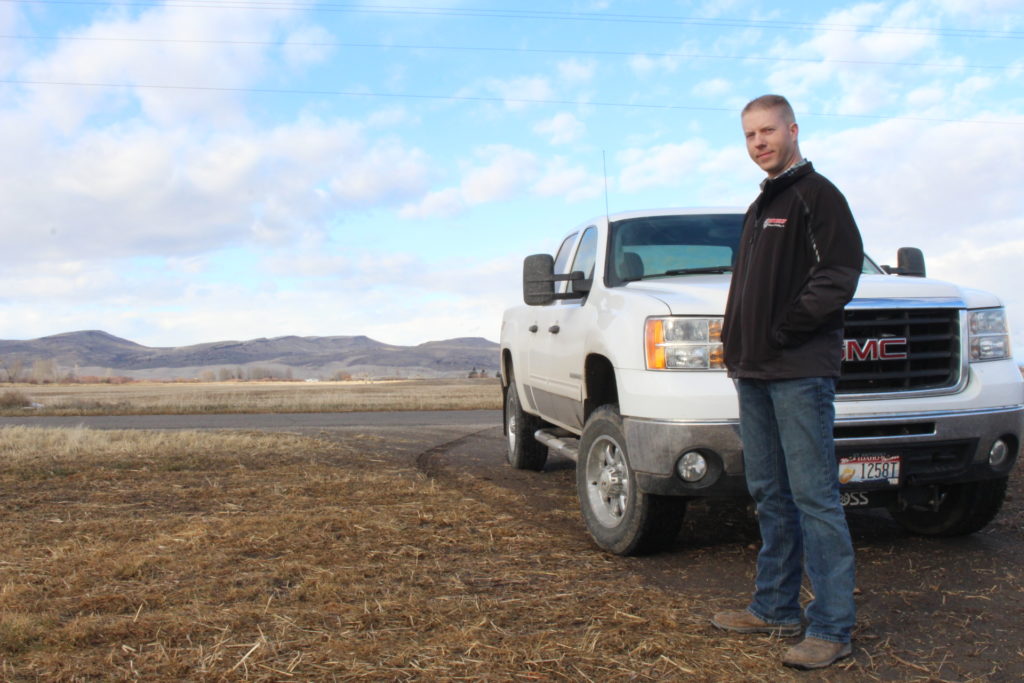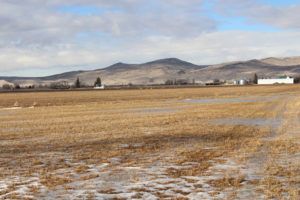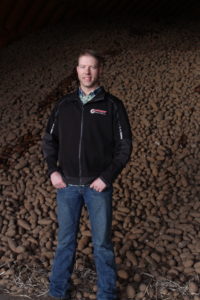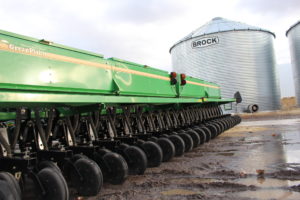
Worth the Effort: Making it work with reduced tillage
There’s a touch of irony in the fact that since taking over his family’s farm, Jeff Parkinson has reduced the amount of fertilizer he needs to use. That’s because for years his family ran a fertilizer business, Parkinson Farm Supply.
“It would be funny to pick his brain and see what he thinks of all this,” he said of his father, Matt.
While looking at his field one unseasonably warm and damp day in February, Parkinson’s neighbor Paul Hemsley stopped by. When the family ran Parkinson Farm Supply, Hemsley was a regular customer.

protected from the winds that whip the sands.
From where they stopped to briefly chat, on land that has been in the Parkinson family for generations, you could see what looked like tan-colored foothills in the distance. Parkinson grows 70 to 100 acres of Russet Burbank potatoes on his family’s farm on the Egin Bench, about four miles south of the St. Anthony Sand Dunes in Madison County, Idaho.
He and his wife, Marcel, both went to the local Brigham Young University-Idaho campus, back when it was still Ricks College. They finished four-year degrees in business management for Marcel and ag business for Jeff, degrees which he said they’re both getting a lot of use out of.
In addition to running the farm, Jeff Parkinson has become a cover crop seed dealer and Marcel runs a dance studio in nearby Sugar City. They’re also starting a new business, renovating a spud storage shed into a reception center in Sugar City, complete with retail spaces that they plan on renting out.
After his dad, Matt Parkinson, passed away in 2010, Jeff took ownership of the family farm. Since then he, like all farmers, has tried different things to make the farm run better. Also, as happens on every farm, some of those have been more successful than others.
One of the challenges he’s faced has been wind erosion. The St. Anthony Sand Dunes is a unique geological area featuring 10,600 acres of white quartz sand, which the wind has sculpted into dunes as tall as 400 to 500 feet, depending on the source you read. (The higher number comes from the Bureau of Land Management and the lower from the local visitor’s bureau.)
The dunes cover roughly a five-mile wide swath that stretches 35 miles long. While not exactly situated on the dunes, Parkinson’s soil is susceptible to erosion from the high winds that whip the nearby sand.

One of the tools that has helped him protect his soil from erosion is a no-till drill. He bought his own drill around three years ago and has begun planting cover crops to keep the soil in place over the winter. His normal rotation is mainly potatoes and wheat with some alfalfa thrown in occasionally.
These practices have let Parkinson reduce the amount of chemical fertilizer he needs to apply.
“They have their place,” he said. “I’m not saying they’re a bad thing, but we depend on them too much.”
He’s tried peas as a cover crop and wants to do more with that particular crop. He’s also planted mustard and radish, which he said do well in cold weather and both have good effects on nematodes. Parkinson is now seeing concrete benefits of these farming practice, but like with everything, there was a learning curve.
In one plot, he was having such a problem with voles eating the cover crop seed that he had to till the plot up and start over. Now his tillage is at a minimum with only having to disc once a year.
“I think the biggest thing that turns them (farmers) away is that it’s expensive – 30 to 60 dollars an acre is kind of what you’re looking at by the time you get it planted,” he said, adding that the price includes the labor and the small amount of fertilizer it takes to get the cover crop established. “But what they don’t realize is I’ve been able to decrease the amount of fertilizer and chemicals I’ve been putting in gradually over the last few years and soil health has been improving as well.”
Parkinson said improving soil health is difficult to measure but he believes it’s happening. One thing that’s a good bit easier to measure is the fact that he’s been able to stop using fumigants in his operation. Also, not having to incur that expense in the fall gives him more options for the following growing season.
Lynn Bagley is chairman of the board of the Teton Soil Conservation District. Teton County is just east of Madison County. Bagley and the district held a soil health workshop this winter and invited Parkinson to come and speak to Teton County farmers about his successes.
He said they invited Parkinson because he’s made practices like cover crops and reduced/ no-till work on his operation.
“The bottom line is building your soil structure so it can function like it used to function. We’ve spent so many years with just tillage, tillage, tillage that it’s kind of a new concept,” Bagley said. “We have to build that soil structure back up to what it was and then you can get by with fewer trips across your field and less fertilizer.”
Having someone who has gone through the process of seeing what works on their operation is important. As an example, Bagley said a few local farmers have tried using a cover crop or reduced tillage but have found their soil has compaction issues that make transitioning quickly a tough process. Another one of the main challenges facing Teton Valley farmers is that the growing season is so short that getting a cover crop established after harvest is difficult or impossible.

makes through the field.
The soil conservation district bought a no-till drill in 2016 and leases it out to farms for $8 a day with a minimum fee of $75. Transportation is up to the grower. The district also offers cost share programs to help relieve the burden of trying out new processes. That includes the Environmental Quality Incentives Program, known as EQIP, through the USDA’s Natural Resources Conservation Service.
“There’s a lot of benefits out there coming down the road, but you’re not going to see all that the first year,” Bagley said. “You have to build your soil structure first. That’s why it takes time.”
For Parkinson that time is worth it. The fact that his soil retains more moisture now means he doesn’t have to irrigate as often, which has led to him not having a problem with white mold for the last several years, something that before was a recurring issue for him.
One of the reasons behind Parkinson’s drive to protect his soil might be his ties to it. He’s the third generation farming the family homestead. He bought the original Parkinson family plot back from his uncle. Other than reducing inputs, investing in his soil is important to Parkinson since it’s what he’ll leave to his four children.
“I think my youngest might be the one that takes over for me when I give it up,” he said, adding his other three children love to farm but have other aspirations as well. “My youngest is my right-hand man. He’s six years old. Whenever he can be here, he’s here.”
If one of them does want to be the fourth generation of Parkinsons to farm on the Egin Bench, Jeff Parkinson said that they will have healthy, fertile soil to plant their crops in.
“I’m putting in half the work and getting the same quality crop, sometimes even better,” he said. “And my farm’s not blowing away either.”














